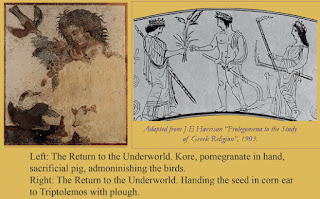HALLOWEEN 4:
The Journey to the Underworld.
In myth Kore the
maid (aka the Virgin; Persephone; Inanna;) journeys to the Netherworld.
Symbolically it is an allegorical representation of the sowing of the
cereals; corn and barley. In Greek myth Kore is made to travel and return
to the underworld. However in the earlier myth from which this
originates, Sumerian Kore is made to stay in the underworld as surety so
her brother Dumuzi is released to fertilise the Earth. Dumuzi (later
Thracian Dionysos; Egytian Osiris;) represents the virility of Nature,
and particularly the verdant corn plant.
Particulars of the
journey are the time - when the pomegranate fruit ripens and bursts -,
and the mode - via the furrow behind the plough -. The pomegranate is a
time-marker, very commonly and symbolically, held prominently in an
outstretched hand. The plough is a central figure in the myth and is
often shown in the hand of Triptolemos the 'thrice-plougher'. The soil
is ploughed before the first rains to better absorb the oft-time scarce
moisture, then sown by scattering seed and ploughed over. Or by
introducing the seed directly into the furrow behind the plough, by a
system of 'plough with seed funnel' also dating back to Sumerian times.
Any exposed seeds are covered by a follower behind the plough.
See: https://www.penn.museum/documents/publications/expedition/PDFs/19-1/Thrice.pdf
In
ancient Greece this folklore was the Thesmophoria. But before was the
Proerosia, the 'before ploughing rites', where animal sacrifice plays a
large part, the pig species being favored by Demeter. (New Light on
Demeter's Mysteries: The Festival Proerosia" Noel Robertson)
There
is then a follow-up to Halloween, according to the ancient Sumerian
'handbook', when the corn seed sprouts, "the farmer should say a prayer
to Ninkilim, the goddess of field mice and vermin, lest these harm the
growing grain; he should also scare away the birds".



Comments
Post a Comment